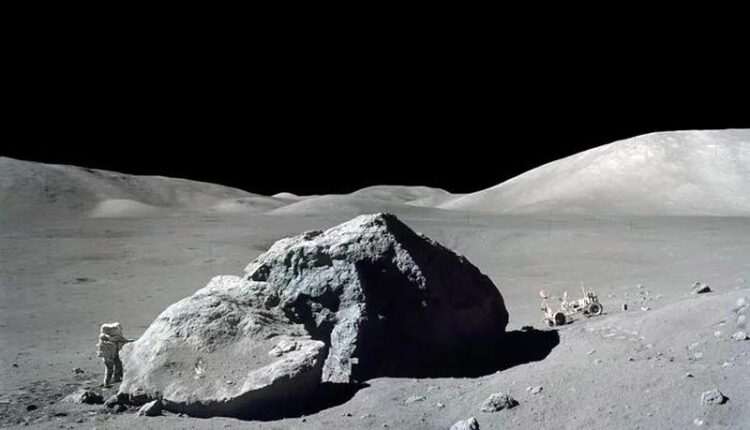Research sheds new light on Moon rock formation

Image shows astronaut-geologist standing next to a huge lunar boulder during NASA’s Apollo 17 mission in 1972. The scientists in this research used rock samples from this Apollo mission.
Credit: NASA/Eugene Cernan
… solving major puzzle in lunar geology.
New research has cracked a vital process in the creation of a unique rock type from the Moon. The discovery explains its signature composition and very presence on the lunar surface at all, unravelling a mystery which has long eluded scientists.
The study, published today in Nature Geoscience, reveals a key step in the genesis of these distinctive magmas. A combination of high temperature laboratory experiments using molten rocks, together with sophisticated isotopic analyses of lunar samples, identify a critical reaction that controls their composition.
This reaction took place in the deep lunar interior some three and a half billion years ago, involving exchange of the element iron (Fe) in the magma with the element magnesium (Mg) in the surrounding rocks, modifying the chemical and physical properties of the melt.
Co-lead author Tim Elliott, Professor of Earth Sciences at the University of Bristol, said: “The origin of volcanic lunar rocks is a fascinating tale involving an ‘avalanche’ of an unstable, planetary-scale crystal pile created by the cooling of a primordial magma ocean.
“Central to constraining this epic history is the presence of a magma type unique to the Moon, but explaining how such magmas could even have got to the surface, to be sampled by Space missions, has been a troublesome problem. It is great to have resolved this dilemma.”
Surprisingly high concentrations of the element titanium (Ti) in parts of the lunar surface have been known since the NASA Apollo missions, back in the 1960s and 1970s, which successfully returned solidified, ancient lava samples from the Moon’s crust. More recent mapping by orbiting satellite shows these magmas, known as ‘high-Ti basalts’, to be widespread on the Moon.
“Until now models have been unable to recreate magma compositions that match essential chemical and physical characteristics of the high-Ti basalts. It has proven particularly hard to explain their low density, which allowed them to be erupted some three and a half billion years ago,” added co-lead author Dr Martijn Klaver, Research Fellow at the University of Münster Institute of Mineralogy.
The international team of scientists, led by the Universities of Bristol in the UK and Münster in Germany managed to mimic the high-Ti basalts in the process in the lab using high-temperature experiments. Measurements of the high-Ti basalts also revealed a distinctive isotopic composition that provides a fingerprint of the reactions reproduced by the experiments.
Both results clearly demonstrate how the melt-solid reaction is integral in understanding the formation of these unique magmas.
Journal: Nature Geoscience
Article Title: ‘Titanium-rich basaltic melts on the Moon modulated by reactive flow processes’
Article Publication Date: 15-Jan-2024
Media Contact
Victoria Tagg
University of Bristol
victoria.tagg@bristol.ac.uk
Office: 44-011-742-84576
All latest news from the category: Earth Sciences
Earth Sciences (also referred to as Geosciences), which deals with basic issues surrounding our planet, plays a vital role in the area of energy and raw materials supply.
Earth Sciences comprises subjects such as geology, geography, geological informatics, paleontology, mineralogy, petrography, crystallography, geophysics, geodesy, glaciology, cartography, photogrammetry, meteorology and seismology, early-warning systems, earthquake research and polar research.
Newest articles

NASA: Mystery of life’s handedness deepens
The mystery of why life uses molecules with specific orientations has deepened with a NASA-funded discovery that RNA — a key molecule thought to have potentially held the instructions for…

What are the effects of historic lithium mining on water quality?
Study reveals low levels of common contaminants but high levels of other elements in waters associated with an abandoned lithium mine. Lithium ore and mining waste from a historic lithium…

Quantum-inspired design boosts efficiency of heat-to-electricity conversion
Rice engineers take unconventional route to improving thermophotovoltaic systems. Researchers at Rice University have found a new way to improve a key element of thermophotovoltaic (TPV) systems, which convert heat…



